HYLC18650-2200mAh圆柱低温锂电池规格书
- 格式:pdf
- 大小:402.28 KB
- 文档页数:13
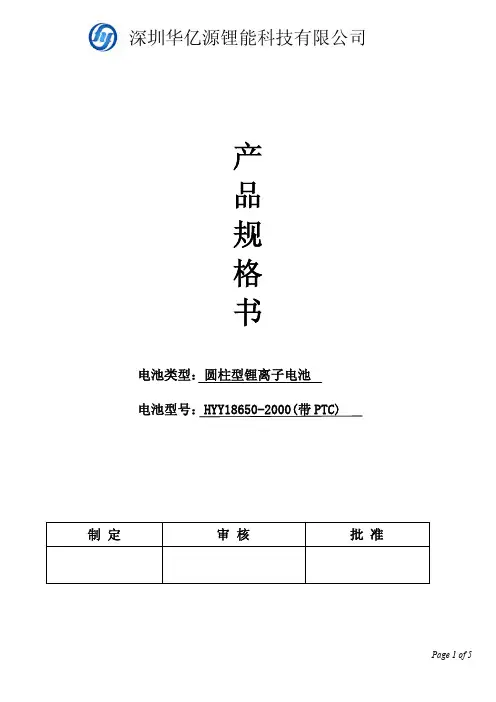
产品规格书电池类型:圆柱型锂离子电池电池型号:HYY18650-2000(带PTC)制 定 审 核 批 准3.0 电池性能3.1电化学性能序号项目标准测试方法1 常温放电性能放电容量/标称容量×100%A)0.2C5A ≥100%B)0.5C5A ≥98%C)1C5A ≥95%在1标准大气压,环境温度25℃±2℃,相对湿度为35%~85%的条件下,电池0.5C标准充电后(以下若没有特别说明,均在此条件下放置,皆按此充电方式),搁置10min,分别以0.2C5A、0.5C5A、1C5A、进行放电至下限电压2.75V,循环三次,当有一次达到标准,即达到标准要求(下同)。
2 常温荷电保持能力剩余容量≥标称容量*85%恢复容量≥标称容量*90%开路电压减小率≤3%内阻增加率≤20%测量电池的初始状态和初始容量,电池标准充电后,开路放置28天,测量电池最终状态;以0.2C5A放电至2.75V,测量电池的剩余容量;0.5C/0.2C测量电池的恢复容量。
可循环三次,当有一次达到标准,即达到标准要求。
1.0 基本特性型号18650-2000外壳材质镀镍钢标称容量(0.2C5A)2000mAh 额定电压 3.7V最大充电电压 4.2 V放电截至电压 2.75V最大充电电流 1 C5A最大放电电流 1 C5A 电池直径(包PVC套)≤18.40mm电池高度(包PVC套) ≤65.30mm电池重量(Approx.) ≤45.2g内阻(Max, at 1000Hz.)≤60 mΩ(充电态)标准0.5 C5A×7.5hrs充电方法(CC/CV) 快速 1 C5A×2.5hrs.放电方法标准0.2 C5A×6 hrs.充电0℃~45℃放电-10℃~50℃操作温度贮存-20℃~25℃2.0 外形图3 循环寿命容量≥标称容量*80%测量电池的初始状态和初始容量,0.5C/0.2C循环300次后测量电池的最终状态。
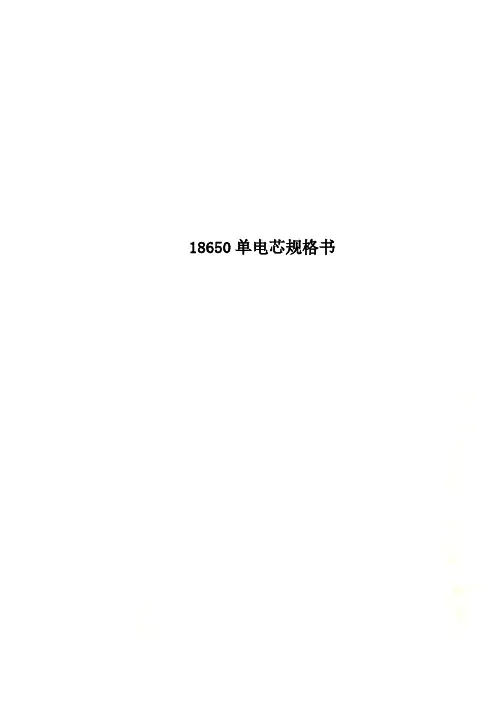
18650单电芯规格书BATTERY CO., LTD. DOC NO.: QR-WI-733-003-002/A REV. : APAGE: 1 of 8Specification Approval Sheet (cylinder Cell) 产品规格确认书(圆柱电池)Model/型号:ZZ18650Capacity/容量:1500mAhVoltage/电压:3.7V制定(Prepared By)审核(CheckedBy)批准(ApprovedBy)DOC NO.: QR-WI-733-003-002/A REV. : APAGE: 2 of 81.0基本特性Basic performance型号Model BJ18650P 外壳材质Can Material 镀镍钢Nickel-plated 标称容量NominalCapacity,(0.2C5A)1300mAh额定电压Nominal 3.70V 充电截止电压Max 4.20 V 放电终止电压 2.80V 最大充电电流Max.Charge Current1C5A标准持续放电流10C5A最大瞬间放电电流Max. Discharge Curent20 C5A电池最大直径(光壳)18.5电池最大高度(光壳)66mm 电池重量(Approx.) 约36g 内阻(Max, at 1000Hz.)≤16mΩ充电方法Charge 标准0.2C5A×快速 1 C5A×操作温度Operating Temperature 充电Charge0℃~45℃放电Discharge-20℃~60℃贮存Storage-10℃~45℃2.0 外形图figure2.1结构图Structure3.0 主要放电曲线Mainly capability graphBJ18650P-1300mAh 15C Discharge Cruve BJ18650P-1300mAh 1C Charge CruveBJ18650P-1300mAh 13C Cycle Life BJ18650P-1300mAh -20℃Discharge CruveDOC NO.: QR-WI-733-003-002/A REV. : APAGE: 3 of 84.0 电池性能Characteristic若没有特别说明,电池在做各项试验前,均需在86KPa~106 KPa大气压,环境温度20℃±5℃,相对湿度为45%~75%的条件下,以0.2C5A恒流放电至终止电压2.8V,并在收到产品两周内进行以下试验。
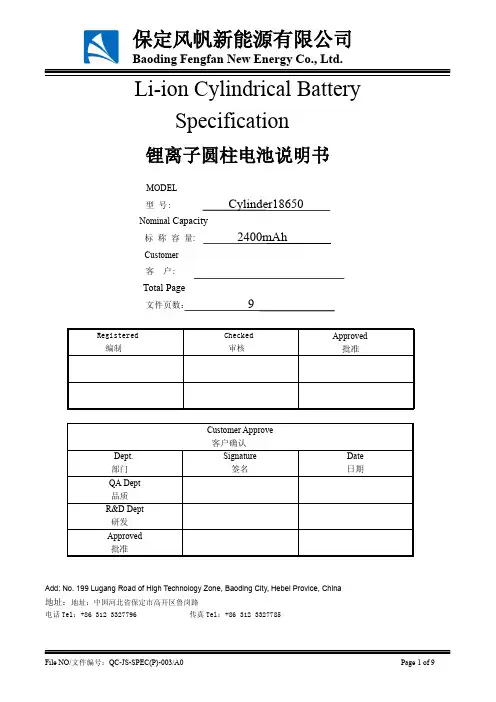
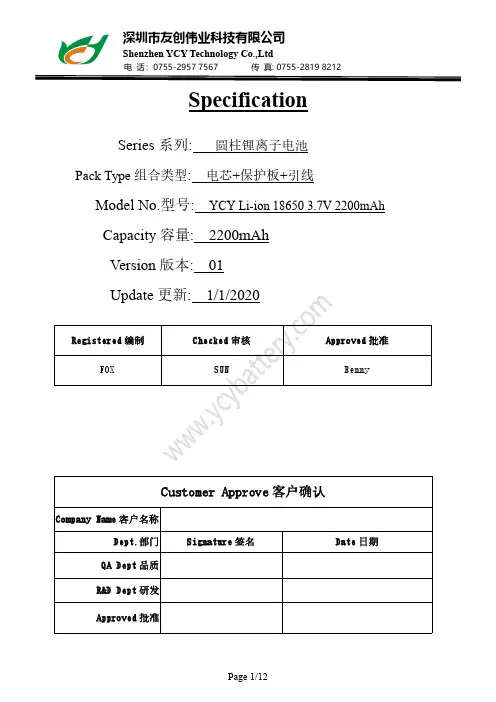
SpecificationSeries系列:圆柱锂离子电池Pack Type组合类型:电芯+保护板+引线Model No.型号:YCY Li-ion186503.7V2200mAhCapacity容量:2200mAhVersion版本:01Customer Approve客户确认Company Name客户名称Dept.部门Signature签名Date日期QA Dept品质R&D Dept研发Approved批准1.SCOPE使用范围This specification is applied to the reference battery in this specification and manufactured by Shenzhen YCY Technology Co.,Ltd本说明书适用于本书中所提及的深圳市友创伟业科技有限公司生产的锂电池。
12Max.Continuous Discharge Current最大连续放电电流 1.5CmA 13Operation Temperature Range操作温度Charge 充电:0~45℃60±25%R.H.Discharge 放电:-20~60℃14Storable Temperature Range储存温度1year 一年-20~25℃60±25%R.H.3months 三个月-20~40℃1week 一周-20~60℃15Weight 重量Approx 约:48.0gBattery pack 电池包16Dimension尺寸Height :64.9±0.2mm (Max.50.1mm )Battery CELL电芯Diameter :18.3±0.1mm (Max.18.4mm )3.Performance And Test Conditions3.1Standard Test Conditions 标准测试条件Test should be conducted with new batteries within one week after shipment from our factory and the batterys shall not be cycled more than five times before the test.Unless otherwise defined,test and measurement shall be done under temperature of 20±5℃and relative humidity of 45~85%.If it is judged that the test results are not affected by such conditions,the tests may be conducted at temperature 15~30℃and humidity 25~85%RH.测试必须使用出厂时间不超过一个星期的新电池,且未进行过五次以上的充放电循环。
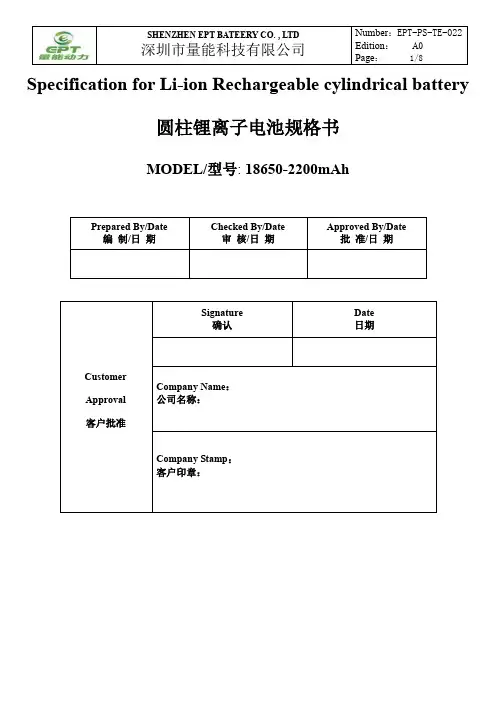
Specification for Li-ion Rechargeable cylindrical battery圆柱锂离子电池规格书MODEL/型号: 18650-2200mAh1.0 SPECIFICATIONS基本特性2.0 CONFIGURATION外形图DiameterHeight3.0 The definitions of some nomenclatures of this specification标准中的一些术语的定义:(1)Standard Charge: Charge with current 0.5C5A to limit charge voltage 4.2V under the condition of 25℃±5℃surrounding temperature, then change to charge with constant voltage till the current less than or equal to 0.01 C5A.标准充电:在环境温度20℃±5℃的条件下,以0.5C5A充电,当电池端电压达到充电限制电压4.2V时,改为恒压充电,直到充电电流小于或等于0.01C5A后停止充电(2)Initial State: The initial appearance, open-circuit voltage and internal resistance of battery.初始状态:电池的初始外观、开路电压、交流内阻。
(3)Final State: The final appearance, open-circuit voltage and internal resistance of battery.最终状态:电池的最终外观、开路电压、交流内阻。
(4)Residual Capacity: After a specific testing program, the first discharge capacity of battery.剩余容量:电池经过特定的检测程序后的首次放电容量。
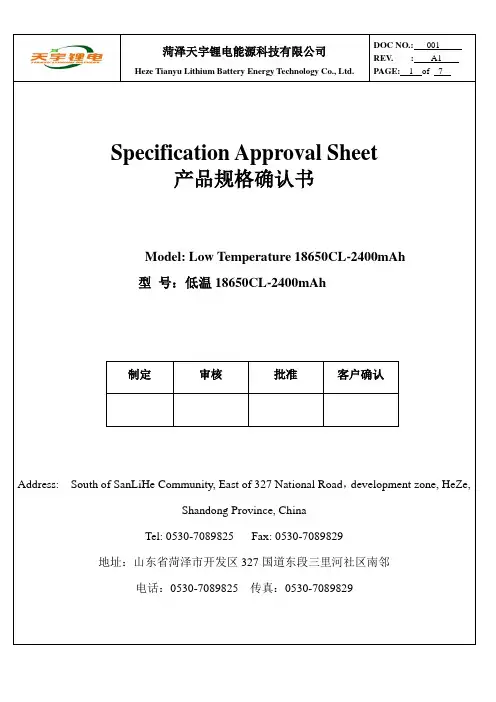
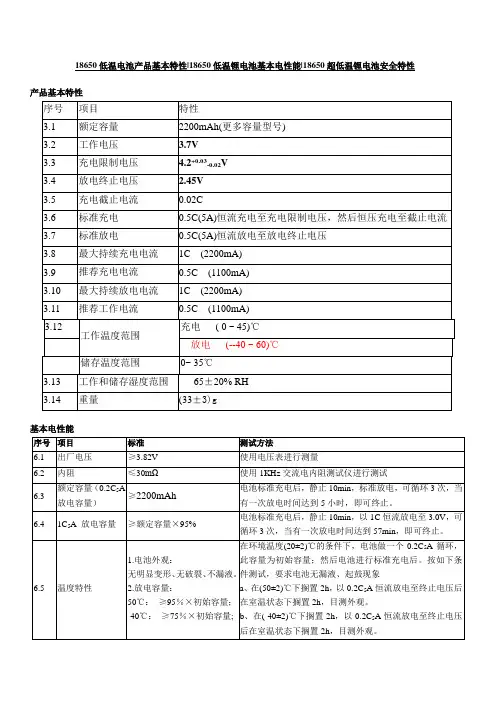

18650单电芯规格书BATTERY CO., LTD. DOC NO.: QR-WI-733-003-002/A REV. : APAGE: 1 of 8Specification Approval Sheet (cylinder Cell) 产品规格确认书(圆柱电池)Model/型号:ZZ18650Capacity/容量:1500mAhVoltage/电压:3.7V制定(Prepared By)审核(CheckedBy)批准(ApprovedBy)DOC NO.: QR-WI-733-003-002/A REV. : APAGE: 2 of 81.0基本特性Basic performance型号Model BJ18650P 外壳材质Can Material 镀镍钢Nickel-plated 标称容量NominalCapacity,(0.2C5A)1300mAh额定电压Nominal 3.70V 充电截止电压Max 4.20 V 放电终止电压 2.80V 最大充电电流Max.Charge Current1C5A标准持续放电流10C5A最大瞬间放电电流Max. Discharge Curent20 C5A电池最大直径(光壳)18.5电池最大高度(光壳)66mm 电池重量(Approx.) 约36g 内阻(Max, at 1000Hz.)≤16mΩ充电方法Charge 标准0.2C5A×快速 1 C5A×操作温度Operating Temperature 充电Charge0℃~45℃放电Discharge-20℃~60℃贮存Storage-10℃~45℃2.0 外形图figure2.1结构图Structure3.0 主要放电曲线Mainly capability graphBJ18650P-1300mAh 15C Discharge Cruve BJ18650P-1300mAh 1C Charge CruveBJ18650P-1300mAh 13C Cycle Life BJ18650P-1300mAh -20℃Discharge CruveDOC NO.: QR-WI-733-003-002/A REV. : APAGE: 3 of 84.0 电池性能Characteristic若没有特别说明,电池在做各项试验前,均需在86KPa~106 KPa大气压,环境温度20℃±5℃,相对湿度为45%~75%的条件下,以0.2C5A恒流放电至终止电压2.8V,并在收到产品两周内进行以下试验。
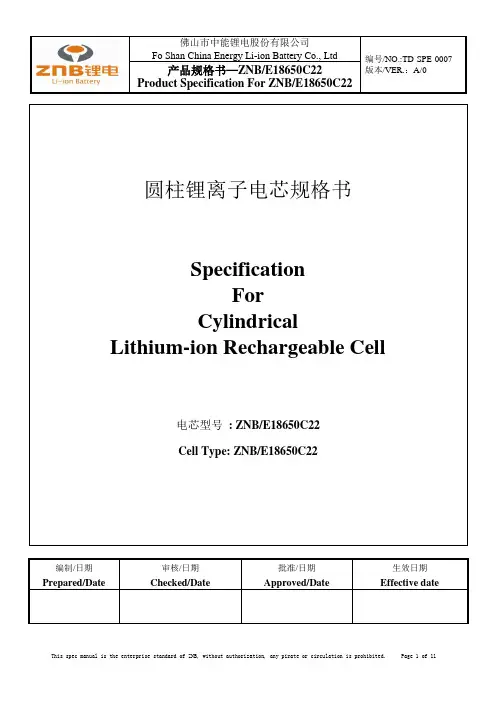
1Preface 前言Maximum allowable charge andHigh-LowNO. 序号ITEM 项目6 Package picture包装图片Small box big box pallet(50pcs cells in a small box, 6 small boxes in a big box)7 Guaranteed and product liability 保质期及产品责任Guaranteed from the date of delivery is the first six months保质期是从出厂日期开始起6个月8Warning and cautions in handling the lithium-ion cell电芯使用时警告事项及注意事项To prevent the possibility of the cell from leaking, heating, explosion, please observe the following precautions:为防止电芯可能发生泄露,发热,爆炸,请注意以下预防措施:Don’t immerse the cell in water.严禁将电芯浸入水中。
保存不用时,应放置在阴凉干燥的环境中。
Caution小心If the cell leaks and the electrolyte get into your eyes, don’t wipe eyes, instead, thoroughly rinse the版本V ersionThis spec manual is the enterprise standard of ZNB, without authorization, any pirate or circulation is prohibited. Page 11 of 11。
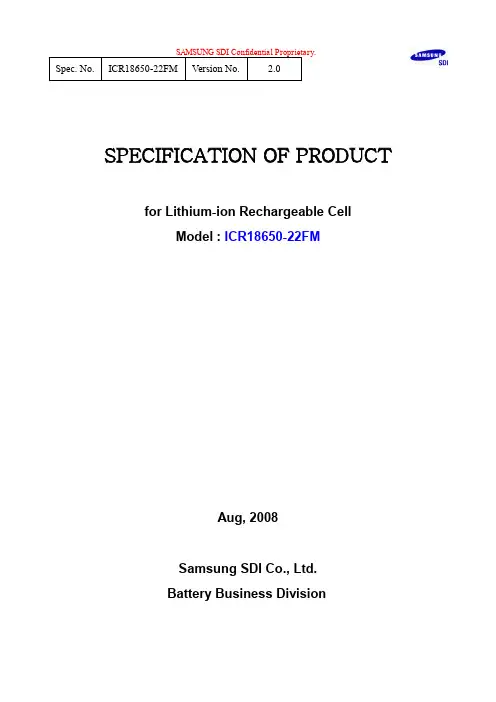
SPECIFICATION OF PRODUCTfor Lithium-ion Rechargeable CellModel : ICR18650-22FMAug, 2008Samsung SDI Co., Ltd.Battery Business DivisionHistory of Revisions1. ScopeThis product specification has been prepared to specify the rechargeable lithium-ion cell ('cell') to be supplied to the customer by Samsung SDI Co., Ltd.2. Description and Model2.1 Description Cell (lithium-ion rechargeable cell)2.2 Model ICR18650-22FM3. Nominal SpecificationsNote (1): If the cell is kept as ex-factory status(50% of charge),the capacity recovery rate is more than 80%.4. Outline DimensionsSee the attachment(Fig. 1)5. AppearanceThere shall be no such defects as scratch, rust, discoloration, leakage whichmay adversely affect commercial value of the cell.6. Standard Test Conditions6.1 Environmental ConditionsUnless otherwise specified, all tests stated in this specification areconducted at temperature 25±5℃and humidity 65±20%.6.2 Measuring Equipment(1) Ammeter and VoltmeterThe ammeter and voltmeter should have an accuracy of the grade 0.5 or higher.(2) Slide caliperThe slide caliper should have 0.05 mm scale.(3) Impedance meterThe impedance meter with AC 1kHz should be used.7. Characteristics7.1 Standard ChargeThis "Standard Charge" means charging the cell with charge current1100mA and constant voltage 4.2V at 25℃for 3hours.7.2 Standard Discharge CapacityThe standard discharge capacity is the initial discharge capacity of the cell, which is measured with discharge current of 440mA with 2.75V cut-off at 25℃within 1 hour after the Standard charge.Standard Discharge Capacity ≥2150mAh7.3 Initial internal impedanceInitial internal impedance measured at AC 1kHz after Standard charge.Initial internal impedance ≤100mΩ7.4 Temperature Dependence of Discharge CapacityDischarge capacity comparison at each temperature, measured with dischargeconstant current 1100mA and 2.75V cut-off with follow temperature after the standard charging at 25℃.Note: If charge temperature and discharge temperature is not the same,the interval for temperature change is 3 hours.Percentage as an index of the Standard discharge capacity(=2150mAh) is 100%.7.5 Temperature Dependence of Charge CapacityCapacity comparison at each temperature, measured with dischargeconstant current 1000mA and 2.75V cut-off at 25℃after the Standard charge isas follow temperature.Note: If charge temperature and discharge temperature is not the same,the interval for temperature change is 3 hours.Percentage as an index of the Standard discharge capacity(=2150mAh) is 100%.7.6 Charge Rate CapabilitiesDischarge capacity is measured with constant current 440mA and 2.75V cut-offafter the cell is charged with 4.2V as follows.Note: Percentage as an index of the capacity at 25℃(=2150mAh) is 100%.7.7 Discharge Rate CapabilitiesDischarge capacity is measured with the various currents in under table and 2.75Vcut-off after the standard charge.Note: Percentage as an index of the capacity at 25℃(=2150mAh) is 100%.7.8 Cycle LifeEach cycle is an interval between the charge (charge current 1760mA) and thedischarge (discharge current 2200mA) with 2.75V cut-off. Capacityafter 299cycles and plus 1 day, measured under the same condition in 7.2Capacity ≥1500mAh7.9 Storage CharacteristicsCapacity after storage for 30days at 25℃after the Standard charged,measured with discharge current 1100mA with 2.75V cut-off at 25℃.Capacity retention(after the storage) ≥1720mAh7.10 Status of the cell as of ex-factoryThe cell should be shipped in 50% charged state.8. Mechanical Characteristics8.1 Drop TestTest method: Cell(as of shipment or full charged) drop onto the oak-board(thickness:≥30mm) from 4feet height at a random direction 6 times.Criteria: No leakage8.2 Vibration TestTest method: Cell(as of shipment) is vibrated along 2 mutuallyperpendicular axes with total excursion of 1.6mm and withfrequency cycling between 10Hz and 55Hz by 1Hz/min.Criteria: No leakage9. Safety10.1 Overcharge TestTest method: To charge the standard charged cell with 12V and 2200mA at 25℃for 2.5 hours.Criteria: No fire, and no explosion.10.2 External Short-circuit TestTest method: To short-circuit the standard charged cell by connecting positive and negative terminal by less than 50mΩwire for 3 hours.Criteria: No fire, and no explosion.10.3 Reverse Charge TestTest method: To charge reversely the standard charged cell with charge current2200mA for 2.5 hours.Criteria: No fire, and no explosion.10.4 Heating TestTest method: To heat the standard charged cell at heating rate of 5℃per minute up to 130℃and keep the cell in oven for 60 minutes.Criteria: No fire, and no explosion.10. WarrantySamsung SDI will be responsible for replacing the cell against defects or poor workmanship for 15month from the date of shipping. Any other problems caused by malfunction of the equipment or unsuitable use of the cell are not under this warranty.The warranty set forth in proper use, handling conditions described above,and excludes in the case of a defect which is not related to manufacturing of the cell.11. Others12.1 Storage for a long timeIf the cell is kept for a long time(3months or more), It is strongly recommendedthat the cell is preserved at dry and low-temperature.12.2 OtherAny matters that specifications does not have, should be conferred withbetween the both parties.12. PackagingSee Fig.2,Package DrawingFig. 1 Outline Dimensions of ICR18650-22FMUnit : mm Max. 18.4 Max. 65.0Fig 2. Package DrawingProper Use and Handling of Lithium Ion CellsSee before using lithium-ion cellSupplied bySamsung SDIEM1. GeneralThis document has been prepared to describe the appropriate cautions and prohibitions, which the customer should take or employ when the customer usesand handles the lithium ion cell to be manufactured and supplied by Samsung SDIEM in order to obtain optimum performance and safety.2. Charging2.1 Charging currentCharging current should be less than maximum charge current specified inthe product specification.2.2 Charging voltageCharging should be done by voltage less than that specified inthe product specification.2.3 Charging timeContinuous charging under appropriate voltage does not cause any loss ofcharacteristics. However, the charge timer is recommended to be installedfrom a safety consideration, which shuts off further charging at time specifiedin the product specification.2.4 Charging temperatureThe cell should be charged within a range of specified temperatures inthe product specification.2.5 Reverse chargingThe cell should be connected, confirming that its poles are correctly aligned.Inverse charging should be strictly prohibited. If the cell is connectedimproperly, it may be damaged.3. Discharging3.1 Discharging3.1.1 The cell should be discharged at less than maximum discharge currentspecified in the product specification.3.2 Discharging temperature3.2.1 The cell should be discharged within a range of temperatures specified inthe product specification.3.2.2 Otherwise, it may cause loss of characteristics.3.3 Over-discharging3.3.1 The system should be equipped with a device to prevent further dischargingexceeding discharging cut-off voltage specified in the productspecification.(over-discharging)3.3.2 Over-discharging may cause loss of performance, characteristics, ofbattery function.3.3.3 Over-discharging may occur by self-discharge if the battery is left fora very long time without any use.3.3.4 The charger should be equipped with a device to detect cell voltage and todetermine recharging procedures.4. Storage4.1 Storage conditions4.1.1 The cell should be stored within a range of temperatures specifiedin the product specification.4.1.2 Otherwise, it may cause loss of characteristics, leakage and/or rust.4.2 Long-term storage4.2.1 The cell should be used within a short period after charging becauselong-term storage may cause loss of capacity by self-discharging.4.2.2. If long-term storage is necessary, the cell should be stored at lowervoltage within a range specified in the product specification, becausestorage at higher voltage may cause loss of characteristics.5. Cycle life5.1 Cycle life performance5.1.1 The cell can be charged/discharged repeatedly up to times specified inthe produce specification with a certain level of capacity also specifiedin the product specification.5.1.2 Cycle life may be determined by conditions of charging, discharging,operating temperature and/or storage.6. Design of System6.1 Connection between the cell and the battery6.1.1 The cell should not be soldered directly with leads. Namely, the cellshould be welded with leads on its terminal and then be soldered withwire or leads to soldered lead.6.1.2 Otherwise, it may cause damage of component, such as separator andinsulator, by heat generation.6.2 Positioning the battery in the System6.2.1 The battery should be positioned as possible as far from heat sourcesand high temperature components.6.2.2 Otherwise, it may cause loss of characteristics.6.3 Mechanical shock protection of the battery6.3.1 The battery should be equipped with appropriate shock absorbers in order tominimize shock.6.3.2 Otherwise, it may cause shape distortion, leakage, heat generationand/or rupture.6.4 Short-circuit protection of the cell6.4.1 The cell is equipped with an insulating sleeve to protect short-circuit whichmay occur during transportation, battery assembly and /or systemoperation.6.4.2 If the cell sleeve is damaged by some causes such as outside impact,it may cause short-circuit with some wiring inside the battery.6.5 Connection between the battery and charger/system6.5.1 The battery should be designed to be connected only to the specifiedcharger and system.6.5.2 A reverse connection of the battery, even in the specified system,should be avoided by employing special battery design such asa special terminals.7. Battery Pack Assembly7.1 Prohibition of usage of damaged cell7.1.1 The cell should be inspected visually before battery assembly.7.1.2 The cell should not be used if sleeve-damage, can-distortion and/orelectrolyte-smell is detected.7.2 Transportation7.2.1 If the cell is necessary to transport to order place, such as thebattery manufacturer, careful precautions should be taken to avoiddamage of cell.8. Others8.1 Disassembly8.1.1 The cell should not be dismantled from the battery pack.8.1.2 Internal short-circuit caused by disassembly may lead to heat generationand/or venting.8.1.3 When the electrolyte is coming in contact with the skin or eyes,wash immediately with fresh water and seek medical advice.8.2 Short-circuiting8.2.1 Short-circuit results in very high current which leads to heat generation.8.2.2 An appropriate circuitry should be employed to protect accidentalshort-circuiting.8.3 Incineration8.3.1 Incinerating and disposing of the cell in fire are strictly prohibited,because it may cause rupture.8.4 Immersion8.4.1 Soaking the cell in water is strictly prohibited, because it may causemelt of components to damaged to functions.8.5 Mixing use8.5.1 Different types of cell, or same types but different manufacturer's cellmay lead to cell rupture or damage to system due to the differentcharacteristics of cell.8.6 Battery disposal8.6.1 Although the cell contains no environmentally hazardous component,such as lead or cadmium. the battery should be disposed according tothe local regulations when it is disposed.8.6.2 The cell should be disposed with a discharged state to avoid heat generationby an inadvertent short-circuit.8.7 Caution - The Battery used in this device may present a risk of fire or chemical burn ifmistreated. Do not disassemble, heat above 100℃or incinerate. Replacebattery with Samsung SDI battery only. Use of another battery may present a riskof fire or explosion. Dispose of used battery promptly. Keep away from children.Do not disassemble and do not dispose of in fire.8.8 AttachedSystem Pack Quality Guideline8-8-1 The battery pack’s consumption current.- Sleep Mode: Under 250uA.- Shut Down Mode: Under 10uA (under 2.5V).8-8-2 SOC 0%- Any bank voltage in SOC 0% of Pack should be higher than 3.0V.(Discharging Cut-off Voltage)8-8-3 Operating Charging Voltage of a cell.- Normal operating voltage of cell is 4.20V.- Max operating voltage of cell is 4.25V.8-8-4 No continuous charge- Charge cut-off condition : Cut-off Current is higher than 1/20C(Charging method: CC-CV)- Initial recharging condition : Remaining Capacity is lower than 90% or Voltageis lower than 4.10V8-8-5 Pre-charging function- Pre-charge function should be implemented to prevent abnormal high ratecharging after deep discharge.- Pre-charging condition :Operation: less than 3.0VCharging current : Under 150mA/Cell.(Continuous)Pre-charge stop (Normal Charge Start) : All cells reach 3.0V8-8-6 Cell voltage monitoring system.- The system (Charger or Pack) should equip a device to monitor each cellvoltage and to stop charging if a cell imbalance happened.8-8-7 The battery pack should have warning system for over temperature, over voltage, over current, and unexpected events would be harm to system. If battery facesharsh condition such as over temperature, Battery pack should control FET-offdirectly.8-8-8 Mechanical guides.- PCBA and Cell stack should have heat insulation material between them. (Suchas plastic barrier which is giving air isolation or non-thermal conductivematerial.)- B+ and B- wire connection should not be crossed each other. Do not make wirewhich had the voltage difference more than 4.0V get together.- The material such as double sided tape and rubber which are used in batterypack should be verified for its flammabilityHandling Precaution and Prohibitions of Lithium Ion & Lithium Ion PolymerRechargeable Cells and BatteriesInaccurate handling of lithium ion and lithium ion polymer rechargeable battery may cause leakage, heat, smoke, an explosion, or fire.This could cause deterioration of performance or failure. Please be sure to follow instructions carefully.1.1 StorageStore the battery at low temperature (below 20℃is recommended), low humidity, no dust and no corrosive gas atmosphere.1.2 Safety precaution and prohibitionsTo assure product safety, describe the following precautions in the instruction manual of theapplication.[ Danger!]■Electrical misusageUse dedicated charger.Use or charge the battery only in the dedicated application.Don't charge the battery by an electric outlet directly or a cigarette lighter charger.Don't charge the battery reversely.■Environmental misusageDon't leave the battery near the fire or a heated source.Don't throw the battery into the fire.Don't leave, charge or use the battery in a car or similar place where inside of temperature may be over 60℃.Don't immerse, throw, wet the battery in water / seawater.■othersDon't fold the battery cased with laminated film such as pouch and Polymer.Don't store the battery in a pocket or a bag together with metallic objects such as keys, necklaces, hairpins, coins, or screws.Don't short circuit (+) and (-) terminals with metallic object intentionally.Don't pierce the battery with a sharp object such as a needle, screw drivers.Don't heat partial area of the battery with heated objects such as soldering iron.Don't hit with heavy objects such as a hammer, weight.Don't step on the battery and throw or drop the battery on the hard floor to avoid mechanical hock.Don't disassemble the battery or modify the battery design including electric circuit.Don't solder on the battery directly.Don't use seriously scared or deformed battery.Don't put the battery into a microwave oven, dryer ,or high-pressure container.Don't use or assemble the battery with other makers' batteries, different types and/or models of batteries such as dry batteries, nickel-metal hydride batteries, or nickel-cadmium batteries.Don't use or assemble old and new batteries together.[ Warning! ]Stop charging the battery if charging isn't completed within the specified time.Stop using the battery if the battery becomes abnormally hot, order, discoloration, deformation, orabnormal conditions is detected during use, charge, or storage.Keep away from fire immediately when leakage or foul odors are detected. If liquid leaks onto your skin or cloths, wash well with fresh water immediately.If liquid leaking from the battery gets into your eyes, don't rub your eyes and wash them with clean water and go to see a doctor immediately.If the terminals of the battery become dirty, wipe with a dry cloth before using the battery.The battery can be used within the following temperature ranges. Don't exceed these ranges.Charge temperature ranges : 0℃~ 45℃Discharge Temperature ranges : -20℃~ 60℃Store the battery at temperature below 60℃Cover terminals with proper insulating tape before disposal.[ Caution! ]■Electrical misusageBattery must be charge with constant current-constant voltage (CC/CV).Charge current must be controlled by specified value in Cell specification.Cut-off Voltage of charging must be 4.2V.Charger must stop charging battery by detecting either charging time or cur rent specified in Cell’s specification.Discharge current must be controlled by specified value in Cell’s specification.Cut-off Voltage of discharging must be over 2.5V.■othersKeep the battery away from babies and children to avoid any accidents such as swallow.If younger children use the battery, their guardians should explain the proper handling method and precaution before using.Before using the battery, be sure to read the user's manual and precaution of it's handling.Before using charger, be sure to read the user's manual of the charger.Before installing and removing the battery from application, be sure to read user's manual of the application.Replace the battery when using time of battery becomes much shorter than usual.Cover terminals with insulating tape before proper disposal.If the battery is needed to be stored for an long period, battery should be removed from the application and stored in a place where humidity and temperature are low.While the battery is charged, used and stored, keep it away from object materials with static electric chargers.Safety Handling Procedure for the Transporter■Quarantine : Packages that are crushed, punctured or torn open to reveal contents should not be transported. Such packages should be isolated until the shipper has been consulted,provided instructions and, if appropriate, arranged to have the product inspected andrepacked.■Spilled Product : In the event that damage to packaging results in the release of cells or batteries, the spilled products should be promptly collected and segregated and the shippershould be contacted for instructions.Design of positioning the battery pack in application and charger To prevent the deterioration of the battery performance caused by heat, battery shall be positioned away from the area where heat is generated in the application and the charger.Design of the Battery PackBe sure adopting proper safe device such as PTC specified type or model in Cell Specification.If you intend to adopt different safety device which is not specified in Cell Specification, please contact Samsung SDI to investigate any potential safety problem.Be sure designing 2nd protective devices such as PTC & PCM at the same time to protect Celljust in case one protective device is fault.Please contact following offices when you need any help including safety concerns.Samsung SDI Emergency Contact Information■Samsung SDI Headquarter.575 Shin-dong, Youngtong-gu, Suwon, Kyunggi-doTel:(+82)31-210-7114 Fax:(+82)31-8006-3689■Samsung SDI Chonan factory.508, Sungsung-Dong, Chonan City, Chungchongnam-Do, KoreaTel:(+82)41-560-3669 Fax:(+82)41-560-3697■Samsung SDI America office.18600 Broadwick Street Rancho Dominguez CA 90220Tel:(+1)310-900-5205 Fax:(+1)310-537-1033■Samsung SDI Taiwan office.Rm. 3010, 30F., 333, Keelung Rd. Sec. 1, Taipei, TaiwanTel:(+886)2-2728-8469 Fax:(+886)2-2728-8480。
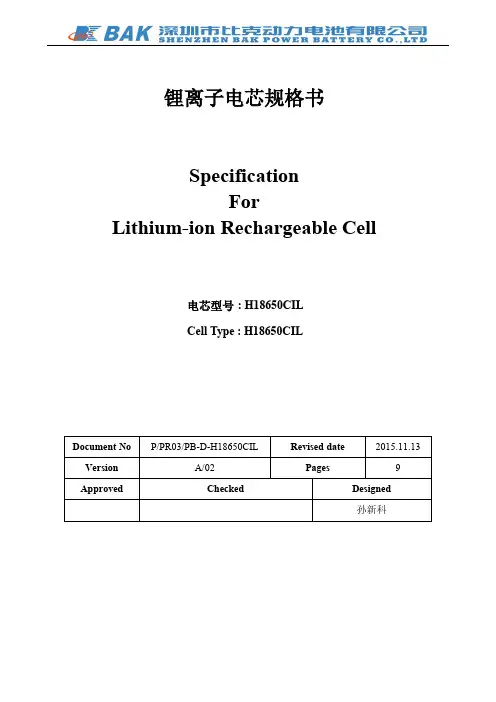
锂离子电芯规格书SpecificationForLithium-ion Rechargeable Cell电芯型号:H18650CILCell Type:H18650CILDocument No P/PR03/PB-D-H18650CIL Revised date2015.11.13 Version A/02Pages9 Approved Checked Designed孙新科Contents目录1Preface前言2Definition定义2.1Rated capacity标称容量2.2Standard charge method标准充电方式2.3Standard discharge method标准放电方式3Cell type and dimension电芯型号及尺寸3.1Description and model电芯说明及型号3.2Cell dimension电芯尺寸4Cell characteristics电芯特性5Technical requirements技术要求5.1Cell usage conditions电芯使用环境5.2Cell testing conditions电芯实验环境5.3Requirement of the testing equipment测量仪表要求5.4Electrochemical characteristics电化学特性5.5Environmental characteristics and safety characteristics环境适应性能与安全性能6Package picture包装图片7Shipment出货8Warranty质量保证9Storage and Shipment Requirement存储及运输要求10Warning and cautions in handling the lithium-ion cell电芯使用时警告事项及注意事项11The restriction of the use of hazardous substances有害物质控制要求12Contact information联系方式13Version history修订履历1Preface前言This specification describes the type and dimension,performance,technical characteristics,warning and caution of the lithium ion rechargeable cell.The specification only applies to H18650CIL cell supplied by Shenzhen BAK Power Battery Co.,Ltd.本标准描述了圆柱型锂离子电芯的外型尺寸、特性、技术要求及注意事项。
圆柱型锂离子电芯规格书PRODUCT SPECIFICATIONCylindrical Lithium-ion Cell电芯型号: LR1865AMSignature 签名Date 日期Company Name :公 司 名 称Customer Approval 客 户 认 同Company Stamp :公 司 印 章Prepared By首 发Checked By 核 对 QA 质量确认 Approved By 批 准Model: LR1865AM适用范围The product specification describes the requirement of the Cylindrical Lithium-ion Cell to be supplied to the customer by Tianjin Lishen Battery J/S Co., Ltd. Should there be any additional information required by the customer, customer are advised to contact Tianjin Lishen Battery J/S Co., Ltd..本规格书规定了由天津力神电池股份有限公司生产的圆柱型锂离子电芯的技术要求,测试方法及注意事项,如需获取本规格书以外的技术要求,请与力神电池股份有限公司联系相关事宜。
2 DESCRIPTION AND MODEL 型号及说明2.1 Description 说明 : Cylindrical Lithium Ion Cell 圆柱型锂离子电芯2.2 Model 电芯型号 : LR1865AM3 GENERAL SPECIFICATIONS 常规指标3.1 Nominal Capacity 标称容量 1100mAh (at 0.55A Discharge 0.55A放电)Minimum Capacity 最低容量 1000mAh (at 0.55A Discharge 0.55A 放电)3.2 Charging Voltage 充电电压 3.60V±0.05V3.3 Average working Voltage 标称电压 3.20V@0.55A3.4 Standard Charge Method 标准充电方式 Constant Current and Constant Voltage (CC/CV)先恒流充电再恒压充电Current 电流 0.55AVoltage 电压 3.6VEnd Current 终止电流 20mA±5mA3.5 Maximum Charge Current 最大充电电流 1.5A3.6 Standard Discharge 标准放电方式 Constant Current 恒流放电 (CC)Current 电流 0.55AEnd Voltage 终止电压 2.0V3.7 Maximum Discharge Current 最大放电电流 25A3.8 Cycle Life 循环寿命 1000th cycle >60% of 4th Capacity (1.5A/10A at 25℃)1000 次循环>60%第四次循环容量 (25℃,1.5A充电/10A放电) 750th cycle >60% of 4th Capacity (1.5A/10A at 45℃)750 次循环>60%第四次循环容量 (45℃,1.5A充电/10A放电) 500th cycle >60% of 4th Capacity (1.5A/10A at 60℃)500 次循环>60%第四次循环容量 (60℃,1.5A充电/10A放电)外形尺寸(单位:mm)Dimension: Diameter 18.4mm (max), Height 65.1mm (max). Refer to the attached drawing 3.电芯尺寸:直径 18.4mm(最大),高度65.15mm(最大),参考附图3。
PRODUCT SPECIFICATIONCylindrical Lithium-ion CellSignature DateCompany NameCustomerApprovalCompany StampPrepared ByChecked ByQA Approved ByTEL: (86) -22-83710503 FAX: (86)-22-83711060Product SpecificationTianjin Lishen Battery Joint-Stock Co., Ltd.CONFIDENTIALREV: V 0TITLE: Cylindrical Lithium Ion Cell LR18650 Page:of101Date: 20080220_______________________________________________________________________________________________________ History of revisionLS431.891GSRevision Date Originator Reason of RevisionFei Original Release0 02/20/2008 XiaoProduct SpecificationTianjin Lishen Battery Joint-Stock Co., Ltd.CONFIDENTIALREV: V 0TITLE: Cylindrical Lithium Ion Cell LR18650 Page:10of2Date: 20080220_______________________________________________________________________________________________________1 SCOPEThe product specification describes the requirement of the Cylindrical Lithium-ion Cell to be supplied to thecustomer by Tianjin Lishen Battery J/S Co.,Ltd.. Should there be any additional information required by thecustomer, customer are advised to contact Tianjin Lishen Battery J/S Co.,Ltd..MODEL2 DESCRIPTIONAND2.1 Description : Cylindrical Lithium Ion Cell2.2 Model : LR18650-2200mAhSPECIFICATIONS3 GENERAL3.1 Nominal Capacity 2200mAh (at 0.2C Discharge)3.2 Charging Voltage4.20V±0.05V3.3 Average working Voltage 3.70V,@0.2C3.4 Standard Charge Method Constant Current and Constant Voltage (CC/CV)Current 0.5C (1100mA)Voltage 4.2VEnd Current 43mA±5mA3.5 Maximum Charge Current 1C (2200mA)3.6 Standard Discharge Constant Current (CC)Current 0.5C (1100mA)End Voltage 3.0V3.7 Maximum Discharge Current 2C (4400mA)3.8 Cycle Life Capacity≥80% Initial Capacity @300th cycles (0.5C/0.5C @25°C )Capacity≥75% Initial Capacity @300th cycles (0.8C/0.5C @25°C)3.9 Weight of Bare Cell Max. 48g3.10 Operating Temperature Charge 0°C ~ 45 °CDischarge -20°C ~ 60°C3.11 Storage Temperature 1 month -20°C ~ 45 °C6 months -20°C ~ 35 °CProduct SpecificationTianjin Lishen Battery Joint-Stock Co., Ltd.CONFIDENTIALREV: V 0TITLE: Cylindrical Lithium Ion Cell LR18650Page: 3 of 10Date: 20080220_______________________________________________________________________________________________________ 4 OUTLINE DIMENSION (UNIT: mm)4.1. Dimension: Diameter 18.4mm (max), Height 65.1mm (max). Refer to the attached drawing 1.5 APPEARANCEThere shall be no such defect as deep scratch, flaw, crack, rust, leakage, which may adversely affect commercial value of the cell.6 TEST CONDITION AND DEFINITIONS6.1 Measuring Equipment1. VoltmeterInner impedance>1000Ω per volt.2. Ampere-meterTotal external resistance(ammeter and wire)<0.01Ω.3. Slide caliperThe slide caliper should have a scale of 0.02mm.4. Impedance meterThe impedance meter should be operated at AC 1KHz.6.2 Unless otherwise specified, all tests shall be performed at (25±2)°C and humidity of (65±20)% RH.6.3 All tests shall be performed at the same charge voltage, per7.1.6.4 Definitions:6.4.1 C Rate (“C”): The rate (milliamperes) at which a fully charged cell is discharged to its end voltage inone (1) hour.7 CHARACTERISTICSmethod:7.1 Charge7.1.1 Charging shall consist of charging at a 0.5C constant current rate until the cell voltage reaches 4.2V.The cell shall then be charged at constant voltage of 4.2 volts while tapering the charge current.Charging shall be terminated when the charging current has tapered to 43mA±5mA.7.1.2 Charging shall consist of charging at a 0.8C constant current rate until the cell voltage reaches 4.2V.The cell shall then be charged at constant voltage of 4.2 volts while tapering the charge current.Charging shall be terminated when the charging current has tapered to 43mA±5mA.method:7.2 Discharge7.2.1 Cells shall be discharged at a constant current of 1C to 3.0 voltsProduct SpecificationTianjin Lishen Battery Joint-Stock Co., Ltd.CONFIDENTIALREV: V 0TITLE: Cylindrical Lithium Ion Cell LR18650Page: 4 of 10Date: 20080220_______________________________________________________________________________________________________7.2.2 Cells shall be discharged at a constant current of 0.5C to 3.0 volts7.2.3 Cells shall be discharged at a constant current of 0.8C to 3.0 volts7.3 Weight of Bare CellMeet 3.10. by balance.Impedance7.4 InternalThe impedance shall be measured at AC 1000 Hz initially.Initial Internal Impedance ≤ 70mohm7.5 Discharge capacity (1C)Within 1 hour after charge as per 7.1.1, discharge at 1C as per 7.2.1 until end of discharge voltage.The capacity≥1908mAh (90%)Life7.6 Cycle7.6.1 Charge cells per 7.1.1. Rest 10 minutes. Discharge per 7.2.2. Rest 10 minutes before recharge. Acycle is defined as one charge and one discharge. Discharge capacity shall be measured after 300cycles.Discharge capacity (300th Cycle) ≥80% of Initial Capacity7.6.2 Charge cells per 7.1.2. Rest 10 minutes. Discharge per 7.2.3. Rest 10 minutes before recharge. Acycle is defined as one charge and one discharge. Discharge capacity shall be measured after 300cycles.Discharge capacity (300th Cycle) ≥75% of Initial CapacityCharacteristics7.7 StorageAfter charge as per 7.1.1, store the testing cells at 25ºC±2ºC for 28 days. Then discharge at 0.5C to 3.0V.The discharge capacity≥80% of Initial capacityCharacteristics7.8 TemperatureCells shall be charged per 7.1.1. and discharged per 7.2.2. Cells , full charged, shall be stored for 3 hours at the test temperature prior to discharging and then shall be discharged at the test temperature. The capacity of a cell at each temperature shall be compared to the capacity achieved at 25ºC and the percentage shall be calculated. Each cell shall meet or exceed the requirements of Table 1.Product SpecificationTianjin Lishen Battery Joint-Stock Co., Ltd.CONFIDENTIALREV: V 0TITLE: Cylindrical Lithium Ion Cell LR18650Page: 5 of 10Date: 20080220_______________________________________________________________________________________________________ Table 1-10°C @ 0.5C 23°C @ 0.5C 60°C @ 0.5C≥50% Initial capacity 100% ≥95% Initial capacity8 SAFETY8.1. External Short-circuiting TestCell, charged per 7.1.1, is to be short circuited by connecting the positive (+) and negative (-) terminals witha total external resistance of less than 50mohm. Stop the test when the battery voltage falls below 0.1V andthe battery case temperature has returned to a value within 10 ºC of the original testing temperature.Criteria: No Explosion, No Fire8.2. Overcharge TestCell, fully discharged per 7.2.2, is to be overcharged with 2C to 10V. Monitoring change of cell temperature during testing. Stop the test when battery temperature decays to room temperature.Criteria: No Explosion, No Fire8.3. Heating TestStore the testing cells connecting with thermocouple in constant temperature box, heating the cells andbox(speed of ascending temperature is 5ºC±2ºC per min) together at room temperature simultaneity, monitor the temperature change of the box, keep for 60 minutes after the box temperature reaches 130ºC±2ºC,then stop the test.Criteria: No Explosion, No Fire8.4. Drop testAfter charge as per 7.1.1, Drop the cells from 4 feet above a wood floor for 9 times.Criteria: Internal impedance≤120mΩ; Change of open circuit voltage≤10%9 GUARANTEECells are guaranteed to be free from defects in workmanship and materials for a period of half a year provided that the manufacturer can confirm such defects are coming from manufacturing abnormality and not from abusive usage, or else manufacturer will solve the quality problem.10 PACKAGINGLoading 100 cells per box, 2 boxes per case for a total of 200 cells. Sketch map refer to attached drawing 211 OTHERSAny matter not included in this specification shall be confered between the both parties.Product SpecificationTianjin Lishen Battery Joint-Stock Co., Ltd.CONFIDENTIALREV: V 0TITLE: Cylindrical Lithium Ion Cell LR18650Page: 6 of 10Date: 20080220_______________________________________________________________________________________________________ 12 SHIPPINGThe capacity of delivery battery is approximately at 50% of charging. During transportation , keep the battery from acutely vibration, impacting, solarization, drenching.Product SpecificationTianjin Lishen Battery Joint-Stock Co., Ltd.CONFIDENTIALREV: V 0TITLE: Cylindrical Lithium Ion Cell LR18650Page: 7 of 10Date: 20080220_______________________________________________________________________________________________________ Attached drawing 1Product SpecificationTianjin Lishen Battery Joint-Stock Co., Ltd.CONFIDENTIALREV: V 0TITLE: Cylindrical Lithium Ion Cell LR18650Page: 8 of 10Date: 20080220_______________________________________________________________________________________________________ Attached drawing 2Product SpecificationTianjin Lishen Battery Joint-Stock Co., Ltd.CONFIDENTIALREV: V 0TITLE: Cylindrical Lithium Ion Cell LR18650Page: 9 of 10Date: 20080220_______________________________________________________________________________________________________ The following caution and warning should appear in manuals and/or instructions for users, especially at the point of use.HANDLING INSTRUCTIONSFORLITHIUM ION RECHARGEABLE BATTERY1. CAUTION1.1 Charginga) Avoid over-charging voltage of charging not over 4.25V.b) Charger should start charging at temperature range 0 ~ 45 °C.c) No reverse charging1.2 Discharginga) Discharge current must be below 2C (4240mA) /cell.b) Discharge end voltage must be over 2.75V.c) Discharge temperature range should be -20 °C ~ 60 °C.1.3 Environmental using conditions:When the battery is charged : 0°C ~+45°CWhen the battery is discharged : -20°C ~+60°C1.4 StorageAny storage, cell should be in a dry area and no corresive gas and no press ong the cell at 20°C ±5°C at half charged stage.When storage within one month :-20°C ~+45°CWhen storage within six month :-20°C ~+35°CWhen storage within twelve month :-10°C ~+25°CProduct Specification Tianjin Lishen Battery Joint-Stock Co., Ltd.CONFIDENTIAL REV: V 0TITLE: Cylindrical Lithium Ion Cell LR18650 Page: 10 of 10 Date: 20080220_______________________________________________________________________________________________________ - Lishen Confidential Proprietary and not be reproduced without written permission from Tianjin Lishen Battery Joint-Stock Co.,Ltd -1.5 Battery position in equipment and charger.To avoid degradation of battery performance by heat, a battery should set the place apart from heat generating electronic parts inside equipment and charger.2. WARNING2.1 Don’t heat or disposed in fire or water .Don’t modify or disassemble the battery. It will be dangerous, and may cause ignition, heating, leakage or explosion.2.2 Don’t short-circuit positive(+) and negative(-) terminals. Keep away from metal or other conductive materials. Jumbling the batteries of direct contact with positive(+) and negative(-) terminals or other conductive materials may cause short-circuit.2.3 Don’t reverse the positive (+) and negative (-) terminals.2.4 If the battery gives off an odor, generates heat, becomes discolored, or in any way appears abnormal during use, recharging or storage, immediately remove it from the device or battery charger and stop using it.2.5 Don’t solder the battery directly. Excessive heating may cause deformation of the battery components such as the gasket, which may lead to the battery swelling,leakage, explosion,or ignition.2.6 Don’t use abnormal cell which has damages by shipping stress, drop, short or something else, and which gives off electrolyte odor.。